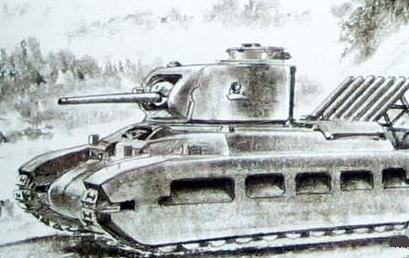Le Tank, Infantry, Mk II, Matilda II (A12)
MAJ 21/03/2008
English Version
Updated 21/03/2008
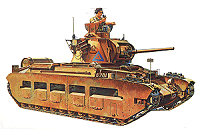
Le Tank, Infantry, Mk II, Matilda II (A12) (parfois présenté comme Senior Matilda) fut un char britannique de la 2° guerre Mondiale. Il a repris le même nom que son prédécesseur le Tank Infantry Mk I (A11). Son surnom provient d’un personnage de dessin mais d’aucun dissent aussi que ce nom vient d’un personnage féminin de la mythologie allemande qui représente une femme combattante extrêmement courageuse .Ainsi le Tank, Infantry, Mk II, Matilda II (A12) fut au début appelé Mathilda II mais lorsque le Mathilda A11 fut retiré du service le Mathilda II devint le Mathilda tout court.
Le concept du char d’infanterie.
Le concept de chars d’infanterie fut développé par les britanniques dans les années précédant la deuxième guerre mondiale. C’était un char plus lourdement armé que le char léger Ce char devait opérer en concert avec l’infanterie l’appuyer la protéger tout en détruisant les défenses qui lui sont opposées. Donc la protection et l’armement devaient primer sur la vitesse. L’origine des chars d’infanterie doit être toutefois recherchée durant la première guerre mondiale les Britanniques firent une différence entre le char lourd du type Mark et le char léger du type Whippet. Dans l’entre-deux-guerres les études se poursuivent sur l’impulsion de Sir Hobbart et Liddel Hart.
Le premier char étudié fut le Mathilda I suivi du Mathilda II du Valentine et du Churchill. La stratégie adoptée était la suivante.
Les chars d’infanterie doivent avancer au rythme de l’infanterie chercher à enfoncer les lignes adverses et ensuite la relève est assurée par des chars légers qui exploitent la trouée.
Ce concept de chars d’infanterie il fut aussi repris par les soviétiques avec le char T 26 et les français avec les chars R et H 35 et 39et B1
A contrario les allemands ont suivi un cheminement totalement différent avec des brigades de chars indépendantes.
Le rôle du char d’infanterie a été tenu chez eux non par des chars mais par des engins du type Stug ou Sturm. Mais ici et je voudrais quand même faire voler en éclats une idée reçue
La conception de l’engin style Sturm ou Stug ne vient pas d’une idée lumineuse de stratèges Allemands mais plutôt des contraintes budgétaires qui ont conduit à construire cet engin qui coûtait beaucoup moins cher qu’un char classique
C’est l’expérience du combat qui a entraîné le développement de ce concert
Développement du char
En 1919 le chef d’état major britannique proposa une nouvelle réorganisation de l’armée avec comme corollaire l’adoption d’un nouveau type de matériel qui doit prendre en compte les récents progrès. De la mécanisation
Des essais furent annoncés et 2 Brigades d’infanterie sont alors désignées pour tester les nouveaux matériels. Ces brigades doivent être soutenues par des chars Carden Loyd Mark VI Les résultats de test prouvent que l’infanterie a besoin de chars pour percer les lignes ennemies Mais ce char doit être lui-même bien protégé pour pouvoir supporter le feu ennemi.
En 1934 l’inspecteur des troupes blindés propose de construire un char d’infanterie qui sera connu sous le nom de Matilda I tank
Deux alternatives se posent alors
le char doit être un char peu blindé et armé de mitrailleuses mais disponible en grande quantité
Le char doit être puissamment protégé plus lourd et équipé d’un canon. , mais disponible en moindre quantités
Les décisions sont prises par le général Sir Hugh Helles vétéran de la première guerre mondiale qui choisit le premier type en fonction des contraintes budgétaires de l’époque et de ses expériences de la première guerre mondiale
Ainsi naquit le Mathilda.I
.jpg) |
Historique.
En octobre 1935 Sir Carden chef du projet chez Victor Armstrong propose au War Office un projet de char (qui deviendra le Mathilda).
Ce char léger armé de mitrailleuses doit être mis en œuvre par deux hommes et pour satisfaire tout le monde il bon marché .Ce projet fut retenu sous le nom de A.11
En 1936 des tests ont lieu. L’engin n’était pas imposant le chef de char prenait place dans une petite tourelle armée de 2 mitrailleuse Vickers. La caisse du char était divisée en 2 parties, avec une partie avant occupée par la chambre de combat avec un homme le conducteur et la partie arrière du char qui était occupée par un moteur Ford V. 8 de 70 chevaux et une boîte à vitesse (BAV) à quatre marches avant La suspension du char était de type Vickers avec 2 boggies de 4 galets. Ce train de roulement était sans aucune protection
Le blindage était assez épais allant jusqu’à 60 mm. Le moteur permettait un déplacement à une vitesse de 16 km /heure
Des modifications furent apportées en 1937. Elles portèrent sur le système de suspension et la motorisation. La tourelle fut aussi modifiée La protubérances qui se trouvaient à l’avant de celle-ci disparu
60 chars furent commandés en 1937. Cette commande fut portée par la suite à 1410 chars au total. Ces engins combattirent aux cotés de leurs successeurs en France en 1940 au sein de la 1st Army tank Brigade et les rescapés servirent ensuite comme char d’entraînement.
Le Matilda II
Le Mathilda I avait des défaut qui ont fait rapidement il devait avoir un successeur. Ces défauts étaient les suivants. Tourelle Monoplace, armement notoirement insuffisant et train de roulement pas protégé
Aussi dès septembre 1936 il fut décidé de concevoir une nouveau modèle de char .Les carences du Mathilda I connues l’équipe d’ingénieurs se mit au travail
Le char est totalement repensé et il en sort un char qui n’a que le nom Mathilda en commun
Le Royal Arsenal de Woolwich produit donc un engin qu reçoit le nom de baptême de GS A12. Il recevra ensuite le nom provisoire Tank, Infantry, Mk II et deviendra ensuite le Mathilda II ou Senior Mathilda. Chose curieuse il reçoit le même nom de baptême que son prédécesseur, d’ou une certaine confusion tout du moins jusqu’en 1940 lorsque les Mathilda I furent retirés du service actif
Il fut construit par Vulcan Foundry.
Le Senior Matilda pèse désormais 27 T soit 15t de plus que son prédécesseur et sa tourelle abritera 3 hommes et sera armée avec le canon QF 2 pounder AT, qui était à l’époque le meilleur canon anti char .
L’équipage est ainsi reparti Le tireur se trouve à l’avant gauche de la tourelle avec le chef de char derrière lui. Il possède un tourelleau sur lequel peu être adapté une mitrailleuse pour un tir anti aérien. Le tireur doit mouvoir le canon en site avec ses épaules alors que la tourelle est mu en azimut par un moteur. Il possède outre le canon d’une mitrailleuse coaxiale Vickers 303 Mg de 7.92mm. Le chargeur se trouve à droite et il possède une écoutille sur le toit de la tourelle
La motorisation était fourni par un modèle dérivé d’un moteur d’autobus comme sur le Whippet dans ce cas de figure c’est un modèle AEC 6 cylindres diesel refroidi par eau de 87 CV . Une boite à vitesse de 6 rapport Wilson complète la motorisation qui lui permet de se mouvoir a 9.5 Kms/h .Mais ce vitesse n’avait aucune importance vu que le char devait se mouvoir au rythme de l’Infanterie.
Sa suspension mise au point par Vickers-Amstrong est connu comme étant celle de Japanese Tank car elle fut développé pour le char japonais Medium C Tank en 1928
Le blindage était de 80mm au maximum et de 20 mm au minimum soit plus que ces concurrents. Grâce à celle-ci, ce char va acquérir une aura d’invincibilité et recevra le surnom de "Queen of the Desert
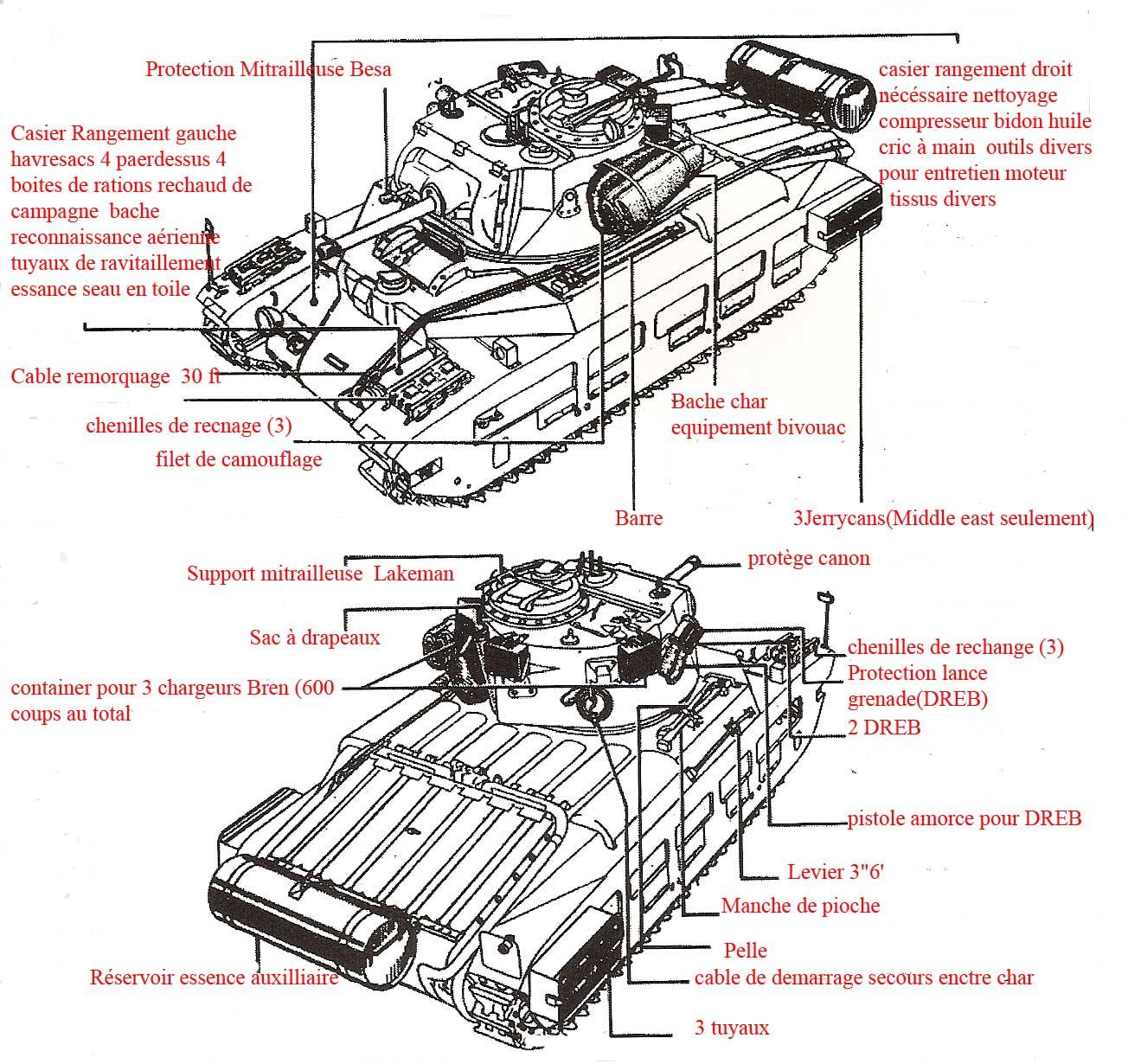 |
| Ecorché du Mathilda 2 |
La production
Le Mathilda II est présenté aux essais en avril 1938. Ceux-ci sont concluant sauf les problèmes classiques du refroidissement du moteur. En juin 1938 les premières commandes sont passées 140 chars auprès de Vulcan Foundry et 40 en septembre auprès de Ruston et Hornsby Ltd de Lincoln
Au total 3000 char seront construits jusqu’en 1942 par diverses entreprises
A titre d’information lors de la période noire de Juin 1940 un car complet fut envoyé aux USA en vue de prévoir la construction d’une chaîne d’assemblage en Amérique .Le car fut étudié par les ingénieurs américains qui vont retenir certaines solutions pour la construction de leur char moyen comme le Sherman
Le Matilda II au combat avec les Anglais
Le BEF en France a besoin de chars, aussi on envoie 5 compagnies de 16 chars avec les moyens organique (il faut savoir que seule le BEF était entièrement motorisé en 1940) A ces chars de combat s’ajouter 7 chars légers de liaison et 8 bren carrier. les Mathilda II au nombre de 23 sont affectés au 7° Royal tank Regiment (RTR ) alors que les Mathilda II sont regroupés au sein du 4° RTR
Les premiers affrontement le 23 mai 1940 autour d’Arras montrent que les Mathilda I et II résistent aux armes anti char allemandes sauf au 88 mm
Après le repli de Dunkerque il ne reste plus en juin 40 que le 8° RTR équipé de Matilda I et II pour défendre l’ile d’une invasion
Mais c’est avec la guerre en Cyrénaïque que le Mathilda va acquérir ses lettres de noblesse . Le Mathilda débarque en Egypte avec le 7° RTR ou le sable libyen lui réussi mieux que la boue européenne. Il s’ensuit 3 ans de durs combats ou les adversaires avancent et reculent au grès de offensives et contre-offensives. Mais le Mathilda trouve son ennemi mortel en la présence du Pak 38. Il commence alors à être remplacé par les Valentine et Crusader. La dernière grande bataille menée par ce char fut la charge héroïque de la Brigade légère de Ruweisat Ridge en juillet 1942 charges suicidaires lors de l’opération Crusader. Les Autres déploiement sur le MTO (mediterranean Theater Operation) vont voir les Mathilda du 4° RTR B squadron être déployés en Erythrée au nombre de 16 . Ensuite nous trouveront des engins du 7°RTR en Crête et à Malte ou ils recevront un camouflage très spécial
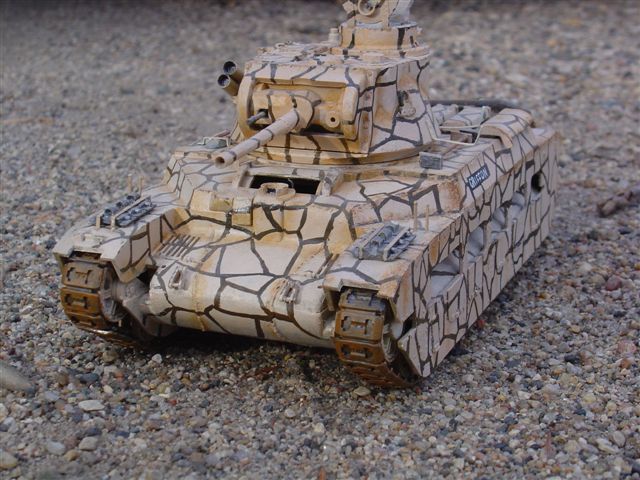 |
| Camouflage Mathilda déployé à Malte |
Le Matilda et l’URSS
Dès l’annonce l invasion de l’URSS par les forces allemandes La Grande Bretagne envoie des armes en URSS. 1000 Mathilda seront ainsi envoyés par bateaux 250 seront perdus
Ces Chars vont combattre lors de la bataille de Moscou. Mais leur vitesse trop lente et le train de roulement qui se bloque en Hiver (neige et boue à font que rapidement ces chars seront relégués à des taches de servitude
Le Matilda et le Canada
Il reçoit des chars dès l’été 1941 qui sont regroupés au sein de la 4° Armored Tank Brigade. Mais les Canadiens vont rapidement abandonner ces chars pour passer sur Churchill et ensuite sur Sherman
Le Matilda et la Nouvelle Zélande
La Nouvelle Zélande a commandé 33 Mathilda pour constituer une force blindée. Son choix c’est porté sur le Mark IV CS mais cette force blindée ne verra jamais le jour et les chars seront reversés aux Australiens
Le Matilda et l Australie
L’Australie sera une grande utilisatrice de ce char et ceci jusqu’en 1955. Elle a utilisé 409 chars et y a apporté diverses modifications
Après avoir combattue en Libye l’Australie après le 6 décembre 1941 privilégie le PTO (Pacific Theater Operation) et envoie ses troupes dans le Sud Est asiatique. Les Mathilda sont déployés et rendent de grands services En effet leur vitesse modeste et leur blindage ne posent aucun problème cars les Japonais ne possèdent pas des chars lourds pour contrer les blindés alliés. Il fut utilisé pour la première fois à Bornéo en Août 1943 au sein de la 1° Armored tank brigade
Le Matilda et les Allemands
97 engins des deux types furent capturés par les allemands en Juin 40 en France . Ils furent employés dans la Wehrmacht sous le vocable Infanterie panzer Mark II 748 (e)
Il existe un photographie montrant un engin modifié en chasseur de char avec un Pak 38 et baptisé Oswald
Sinon Rommel fera réutiliser tous les chars capturés par ses troupes en Libye
Versions du Matilda
Les modifications portent surtout sauf sur les versions CS sur les organes de transmissions Moteur Boite à vitesse et chenilles
Infantry Tank Mark II Char première série (146 construits)
Infantry Tank Mark IIA.Mark II avec mitrailleuse Besa 7.92.
Infantry Tank Mark IIA ou Mark III Moteur .AEC diesel .(675 construits )
Infantry Tank Mark IIICS (Close Support) armé d’un obusier de 3 inch (75 mm)..(168 construits)
Infantry Tank Mark IV:.Infantry Tank Mark IIA avec moteur Leyland (1613 construits)
Infantry Tank Mark V:.Mark-IV avec nouvelle boite à vitesses
Infantry Tank Matilda IV (Infantry Tank Mk IIA) motorisation
Infantry Tank Mathilda V boite à vitesse.
Matilda Scorpion I et II
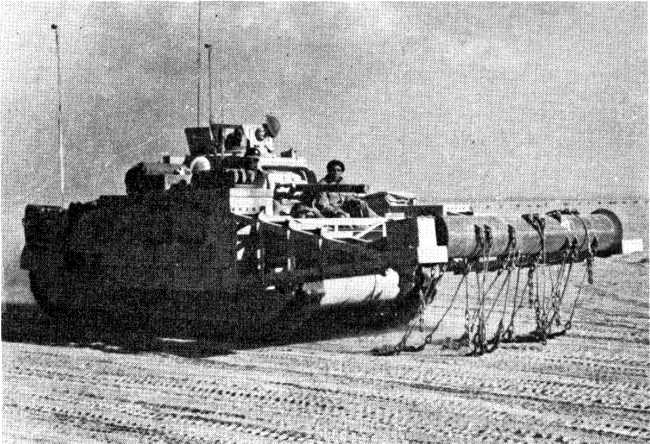 |
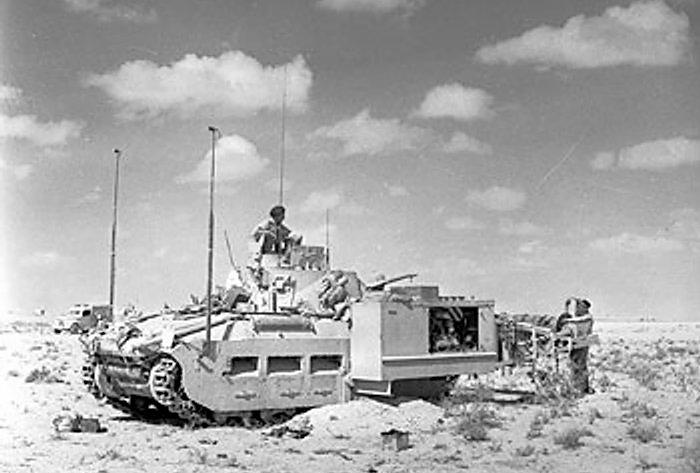 |
Char démineur utilisé en Libye la modification a été effectué en Egypte durant l’été 1942 et elle porte sur 24 engins qui furent prêts pour la Bataille d’El Alamein . Ils servirent ensuite en Tunisie contre la ligne Mareth au début 1943
Matilda Baron I, II, III, IIIA
60 engins furent modifiés mais ils ne furent jamais utilisés Le fléau était mis en oeuvre par 2 moteurs Bedford placés dans des superstructures afin d’accroître la puissance du fléau.
Matilda with AMBA:
vehicule anti mines avec rouleaux
Matilda II et V CDL (canal defense light)
C’était un programme top secret. Les Britanniques ont eu l’idée de convertir certains chars en char projecteur afin d’appuyer les attaques nocturnes. Les chars Mathilda pouvaient indifféremment être équipés de leur tourelle normale ou bien de la tourelle CLD. Seule contrainte en cas de mise en place de la tourelle CLD l’emport d’un générateur auxilliairePar la suite le Mathilda CLD céda sa place au M3 Grant
La tourelle remplacé par une tourelle cylindrique abritant un projecteur et armée d’une mitrailleuse BESA
Matilda with Carrot:.
char déposant des charges de démolition de 272kg mise à feu de l intérieur du char
Matilda Inglis Bridge:.
char pose travelure.
Matilda with crane:.
char maneouvrant avec les Mathilda CLD afin d’assurer la manutention des tourelles CDL
Infantry Matilda Panzerkampfwagen Mark II 748(e):.
char capturé mis en œuvre par les allemands.
Version australiennes
Matilda Frog
25 chars construits Ces chars avaient un lance flamme à la place du canon par contre la mitrailleuse coaxiale été maintenue en place. 2 réservoirs de 454.54 litres en interne et 136.36litres en externe permettaient de projeter un jet enflammé à 83.29 mêtres. Un jet consommait 14.45 litres. Un délai de 30 secondes était nécessaire entre chaque jet
Murray and Murray FT version lance flamme avec de la cordite comme propulseur
Matilda Projector Hedgehog
6 chars construits avec armement d’un mortier naval Hedgehog
Ces mortiers étaient installés dans une boite blindée à l’arrière du châssis. Il était mu en en site par un système hydraulique et mis à feu par un système électrique Une salve de 6 engins pouvait être tirée chaque bombe pesant 30 kgs avec 14 kg d’explosifs. Sa portée etait de 400 mètres
Ils devaient être utilisés contre des Bunkers .Mais ils ne purent servir durant la 2° Guerre Mondiale
Matilda Bulldozer
Il y eu 2 systèmes le Mark 1 avec un système mécanique et le Mark II avec un système hydrauliqueIls furent essayés sans grand succès en août 1945 à Balikapan. La lame étant trop lourde
Production totale Matilda II
| |
fin 1939 |
1940 |
1941 |
1942 |
1943 |
| total |
24 |
368 |
1064 |
1330 |
143 |
Caractéristiques
Tonnage 26,924 T
Equipage 4
Longueur 6,019 m
Largeur 2.6 m
Hauteur 2.5m
Motorisation
2 moteurs Diesel Leyland E 148 ou 149 (Mark III) de 95 CV ou AEC 6 cylindres de 87 CV
Puissance 174 CV et 190 CV
Vitesse maximale 24 Kms/h
Vitesse moyenne 10 km/h
Autonomie 80 Kms
Armement1 canon QF 2 pdr (40 mm) avec 93 obus
V° 853m/s
1 mitrailleuse Besa de 7.92 mm alimentée à 2925 coups
Merci à Franck pour le prêt des images du Mathilda du MRA de Bruxelles
The Tank, Infantry, Mk II, Matilda II (A12)

The Tank, Infantry, Mk II, Matilda II (A12) (sometimes presented as Senior Matilda) was a British tank of WW 2°. He repeated the same name as its predecessor, the Tank Infantry Mk I (A11). His nickname of a character provident drawing any dissent but also that the name comes from a female of German mythology represents a very brave woman fighter. Way, the Tank, Infantry, Mk II, Matilda II (A12) at the beginning was called Mathilda II, but when the A11 Mathilda was removed from service on Mathilda II became the Mathilda only.
The concept of char infantry.
The concept of infantry tanks was developed by the British in the years before WW2. It was a tank more heavily armoured than the slight tank because this tank would be operate in concert with infantry support for protect and destroy all the defenses are opposed to it. So protection and armament should take precedence over speed. The origin of infantry tanks must be sought, however, during WW1 when British made a difference between the HeavyTank type Mark and light tank type Whippet. In the inter-war studies are continuing on the leadership of Sir Hobart and Liddel Hart.
The first tank was studied Mathilda I followed the Mathilda Valentine II and Churchill. The strategy was as follows.
The infantry tanks should move to the rhythm of the infantry trying to push the enemy lines and then the rotation is provided by light tanks who exploit the holes.
This concept of infantry tank will be also used p by the Soviets with the T 26 and french with tanks and R/ H 35 and 39 and B1
Conversely, the Germans have taken a completely different path with independent brigades of tanks.
The role of infantry tank was hold not by tanks but by Stug or Sturm. But here, and I would still have shattered conventional wisdom
The design of the equipment or Stug style Sturm is not a bright idea strategists Germans, but the budgetary constraints that led to construct this device that cost much less than a conventional float
It is the battle experience which led to the development of this concert
Tank development
In 1919 British Chief of Staff proposed a new reorganization of the army as a corollary the adoption of a new type of material that must take into account recent progress especially the mechanization
Tests were announced and 2 Infantry Brigades are designated for testing new equipment. These brigades must be supported by tanks Carden Loyd Mark VI The test results show that the infantry needed tanks breaking through enemy lines But this tank must be itself well protected to be able to withstand enemy fire.
In 1934 the inspector of the Armoured Troops proposing to build a infantry tank which will be known as Matilda I tank
Two alternatives arise
The tank must be a little armoured tank and armed with machine guns but available in large quantities
The tank must be heavily protected heavier and equipped with a cannon. , But in lesser quantities available
General Sir Hugh Helles veteran of WW 1 chooses the first type according to the budgetary constraints of the period and experiences of the WW1
Thus was born the Mathilda.I
History.
In October 1935 Sir Carden project leader atVictor Armstrong suggested to the War Office a tank draft which will become the Mathilda.
This tank armed with light machine guns must be implemented by two men and it is cheap. The project was selected under the name A.11
In 1936 tests were taking place. The vehicle t was not imposing the chief commander took place in a small turret armed of 2 Vickers MG. The frame of the tank was divided in 2 parts, with a front room occupied by combat compartment with a driver and the rear part of the tank, which was occupied by a Ford engine V. 8 of 70 horses and a Gear box with 4 foward gears Suspension of char was Vickers with type 2 bogies of 4 rollers. The running gear was unprotected
The armour d was fairly thick up to 60 mm. The engine allows a shift at a speed of 16 km / hour
Changes were made in 1937. They focused on the suspension system and engine. The turret was also amended the protuberances that were on the front of it disappeared
60 tanks were ordered in 1937. This order was given by the following 140 chars in total. These devices fought alongside their successors in France in 1940 with the 1st Army Brigade tank and then the survivors served as training tank .
The Matilda II
The Mathilda I had a defect which made quickly would have a successor. These defects were as follows.
Monoplace Turett, notoriously inadequate weaponry and running gear not protected
Also in September 1936 it was decided to design a new model of tank. The team of engineers work upon a new Mathilda
The concept of the tank is completely redesigned, and it leaves a tank that has only the name in common Mathilda
The Royal Arsenal in Woolwich product is a vehicle that receives the baptismal name of GS A12. He will then meet the temporary name Tank, Infantry, Mk II and later became the Mathilda II or Senior Mathilda. Curiously he received the baptism of the same name as its predecessor, or some confusion at least until 1940 when I Mathilda were removed from active duty
It was built by Vulcan Foundry.
The Senior Matilda now weighs 27 T is getting 15 T more than its predecessor and its turret shelter 3 men. She is armed with the gun QF 2 pounder AT, which at the time was the best anti-tank gun.
The crew has allocate The shooter is at the left front of the turret with the chief of the tank behind him. He has a cupola where he can be adapted a MG for firing anti aircraft. The shooter must move in the gun site with his shoulders while the turret is driven in azimuth by a motor. It has furthermore the gun a coaxial MG Vickers 303 Mg 7.92mm. The loader is in the right and it has a hatch on the roof of the turret
The motorisation was provided by a engine derived from a bus engine as the Whippet in this scenario is a model AEC 6-cylinder water-cooled diesel from 87 HP. A box speeds of 6 Wilson report complements the engine which enables it to move a 9.5 Km / h. But its speed did not matter because the tank was moving at a rate of Infantry.
The suspension was developed by Vickers-1928 . Ske vwas the same of the Japanese Metium C tank of 1928
The armour had a maximum of 80mm and 20 mm minimum so more than the competitors. Thanks to this armour, this tank will acquire an invincibility aura and given the nickname "Queen of the Desert
 |
| Cut-away of Matilda 2 |
The production
The Matilda II was submitted for testing in April 1938. all its OK except conventional engine cooling. In June 1938 the first 140 orders are placed tanks with Vulcan Foundry and 40 in September from Ruston and Hornsby Ltd Lincoln
In total 3000 were built by various companies until 1942
For information during the dark period of June 1940 a tank was sent to the USA in order to provide for the construction of an assembly line in America. The tank was studied by the American engineers who will retain some solutions the construction of their medium tank as the Sherman
The Matilda II at the battle with the English
The BEF need tanks, so 5 companies with 16 tanks and the means organic (you must know that only the BEF was fully motorized in 1940) were send in France.At these tanks was added 7 light liaison tanks and 8 bren carrier.
The 23 Matilda II, are allocated to the 7 ° Royal Tank Regiment (RTR), and the other Mathilda II are grouped in the 4 ° RTR
The first fight take place on May 23th 1940 around Arras with Mathilda I and II resistant to anti tank weapons except in German 88 mm
After the withdrawal of Dunkirk there remains in June19 40 until the 8 ° RTR equipped with Mathilda I and II to defend the island from invasion
But it is with the war in Cyrenaica that Mathilda will gain his letters patent od nobility. The Mathilda arrive in Egypt with 7 ° RTR , and quickly the Libyan sand succeeded him better than European mud.
Follows 3 years of hard fighting and the opponents are advancing and retreating in offensives and counter-offensives. But Matilda finds its mortal enemy in the presence of Pak 38. He began to be replaced by Valentine and Crusader. The last major battle of this char was the heroic charge of the Light Brigade at Ruweisat Ridge in suicidal charges in July 1942 during Operation Crusader. Other deployment to the MTO (mediterranean Theater Operation) will see 16 Mathilda of 4 ° RTR B squadron to be deployed in Eritrea Then we will find Matilda in the 7 ° RTR in Crete and Malta or they will receive a very special camouflage
 |
| Camouflage Mathilda deployed in Malta |
The Matilda and the USSR
As soon as the invasion of the USSR by German forces Britain sends weapons in the USSR. 1000 Mathilda be sent by boat 250 will be lost
These tanks are present during the Battle of Moscow. But their speed too slow and the running gear, which lock in Winter (snow and mud to make those tanks will be quickly relegated to servitude services
The Matilda and Canada
He receives tanks in summer 1941, which are grouped in the 4 ° Tank Armored Brigade. But Canadians will quickly abandon those tanks for Churchill and then on Sherman
The Matilda and New Zealand
New Zealand has ordered 33 Mathilda to be an armored force. His choice is focused on the Mark IV CS armored force, but this will never see the day and tanks will be donated to Australians
The Matilda and Australia
Australia will be a major user of the char and this until 1955. She used 409 tanks and made several changes Having fought in Libya Australia after December 6th 1941 give preferences to the PTO (Pacific Theater Operation), and sends its troops in South East Asia. The Mathilda are deployed and the give bigs services Indeed modest speed and armour are no a problem because Japanese do not have heavy tanks to counter the armoured allied force. It was first used in Borneo in August 1943 in the 1st Armored tank brigade
The Matilda and Germans
97 tanks of both types were captured by the Germans in France on June 40. They were used in the Wehrmacht under the term Infantry panzer Mark II 748 (e)
There is a photograph showing a modified engine fighter tank with a 38 and Pak called Oswald
Otherwise Rommel will use all captured tanks by his troops in Libya
Versions of Matilda
The modifications bring except on the CS versions on the transmissions Engine gear box and caterpillars
Infantry Tank Char Mark II first bach
Infantry Tank IIA.Mark Mark II MG Besa 7.92.
Infantry Tank Mark IIA or Mark III Engine. AEC diesel.
Infantry Tank Mark III CS (Close Support) armed with a howitzer of 3 inch (75 mm) ..
Infantry Tank Mark IV. Infantry Tank Engine Mark IIA with Leyland
Infantry Tank Mark V:. Mark-IV with new gear box
Matilda Infantry Tank IV (Infantry Tank Mk IIA) motorization
Infantry Tank Mathilda V gear box.
Matilda Scorpion I and II
Char minesweeper used in Libya modification was made in Egypt in the summer of 1942 on 24 tanks that were ready for the Battle of El Alamein. They then served in Tunisia against Mareth Line in early 1943
Baron Matilda I, II, III, IIIA
60 tanks were modificated, but they were never used .the scourge was motorised by 2 Bedford engines placed in the superstructure to increase the power of the scourge.
Matilda with AMBA:
Anti mine tank with anti mines roller s
Matilda II and V CDL (canal defense light)
It was a top secret program. The British had the idea to convert some tanks in char projector to support nocturnal attacks. The Mathilda could be equipped with their standard tower or a CDL turret The only limit his the utilisation of the CLD was the carrying a power unit
Later Mathilda CLD ceded its place M3 Grant
The turret replaced by a cylindrical turret housing a projector and armed with a Besa MG
Matilda with Carrot Tank with demolition charges of 272kg firing from inside the tank
Inglis Matilda Bridge:.
Tank bridge layer.
Matilda with Crane:.
Tank with Mathilda CLD to ensure the handling of turrets CDL
Matilda Infantry Panzer Mark II 748 (e).
Captured tank used by the Germans.
Australian Version
Matilda Frog
25 tanks were constructed with a flamethrower in place of the barrel abut always with the coaxial MG 2 tanks of 454.54 litres internally and 136.36litres externally allowed to project a ignited jet at 83.29 meters. A jet consumed 14.45 litres. A time limit of 30 seconds was needed between each jet
Murray and Murray FT version launches with the flame as a propellant cordite
Matilda Hedgehog Projector
6 tanks built with a mortar weapons naval Hedgehog
These mortars were installed in an armored box at the rear of the chassis. It was put in action by an hydraulic system and ignited by an electrical system A salvo of 6 “bombs” could be shoot and each bomb weighing 30 kg with 14 kg of explosives. It has a range of 400 metres
They were to be used against bunkers. But they could not serve during the World War 2 °
Mathilda Bulldozer
There were 2 systems
the Mark 1 system with a mechanical system and the Mark II with an hydraulic system
The system was tried without great success in August 1945 to Balikapan. The blade being too heavy
Total Production Matilda II
| |
end 1939 |
1940 |
1941 |
1942 |
1943 |
| Production |
24 |
368 |
1064 |
1330 |
143 |
Technical data
Tonnage 26.924 Tons
Crew 4
Length 6.019 m
Width 2.6 m
Height 2.5m
Engine
2 diesel engines Leyland E 148 or 149 (Mark III) of 95 HP or AEC 6-cylinder 87 hp
Power 174 HP and 190 HP
Maximum speed 24 km / h
Average speed 10 km / h
Range 80 Kms
Weaponery
1 X QF 2 pdr (40 mm) with 93 shells
853m V ° / s
1 Besa MG Besa of 7.92 mm with 2925 cartridges
Thank you to Franck for the pics of Mathilda( MRA Brussels )







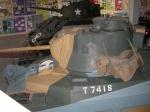
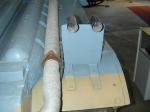
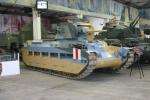
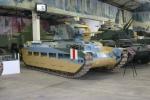
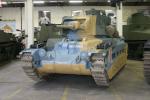
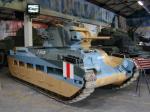
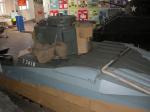
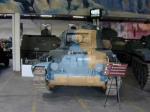
.jpg)




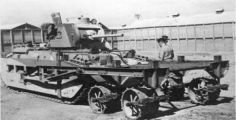
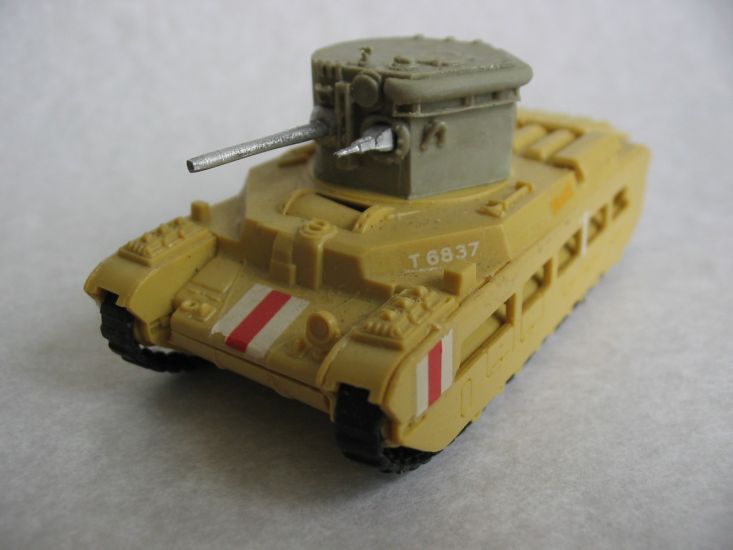
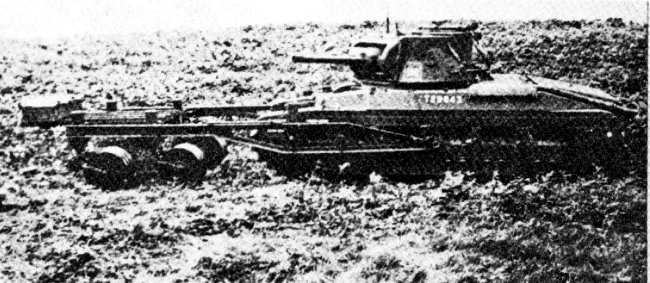
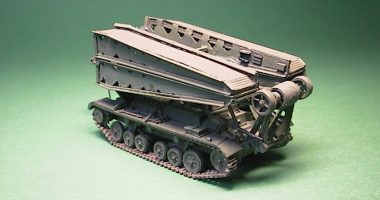
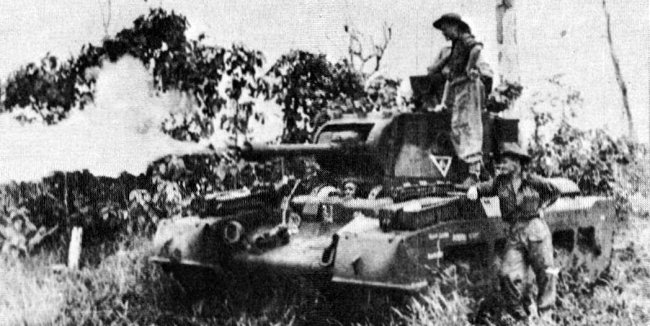
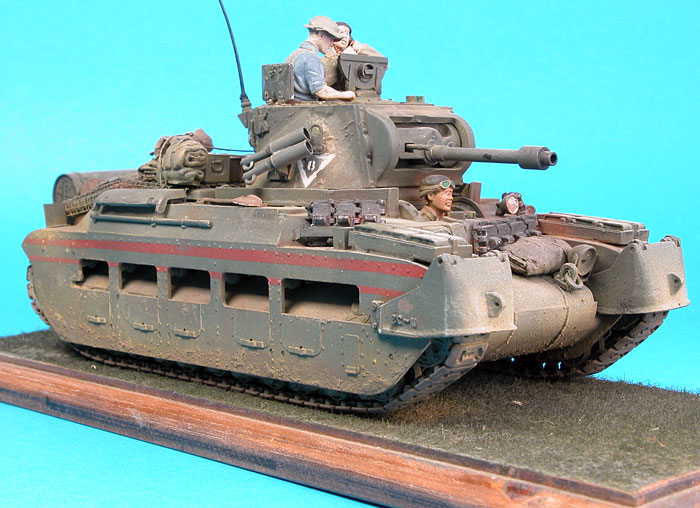
(1).jpg)
